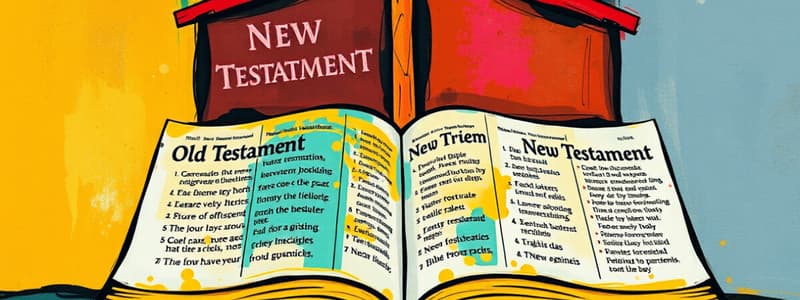Podcast
Questions and Answers
What are the two main sections of the Bible?
What are the two main sections of the Bible?
The two main sections of the Bible are the Old Testament and the New Testament.
Name the first five books of the Old Testament.
Name the first five books of the Old Testament.
The first five books are Genesis, Exodus, Leviticus, Numbers, and Deuteronomy.
Identify one key theme of the Old Testament.
Identify one key theme of the Old Testament.
One key theme is the covenant between God and Israel.
What purpose do the Gospels serve in the New Testament?
What purpose do the Gospels serve in the New Testament?
How many books are in the New Testament?
How many books are in the New Testament?
Describe one aspect of the impact of the Bible on culture.
Describe one aspect of the impact of the Bible on culture.
What languages was the Bible originally written in?
What languages was the Bible originally written in?
Mention one approach to interpreting the Bible.
Mention one approach to interpreting the Bible.
Flashcards are hidden until you start studying
Study Notes
Overview of the Bible
- The Bible is a sacred text in Christianity, consisting of two main sections: the Old Testament and the New Testament.
- It is considered the inspired word of God by believers.
Old Testament
-
Structure:
- Includes 39 books (Protestant version) or more in Catholic and Orthodox versions.
- Divided into several sections:
- Pentateuch: First five books (Genesis, Exodus, Leviticus, Numbers, Deuteronomy).
- Historical Books: Narratives of Israel’s history (e.g., Joshua, Judges, Kings).
- Wisdom Literature: Poems and philosophical writings (e.g., Psalms, Proverbs, Ecclesiastes).
- Prophets: Writings of the prophets (Major: Isaiah, Jeremiah; Minor: Hosea, Amos).
-
Key Themes:
- Creation and fall of humanity.
- Covenant between God and Israel.
- Prophecies of the Messiah.
- Laws and moral teachings.
New Testament
-
Structure:
- Comprises 27 books.
- Key sections include:
- Gospels: Accounts of Jesus’ life (Matthew, Mark, Luke, John).
- Acts of the Apostles: Early church history.
- Epistles: Letters from apostles (e.g., Romans, Corinthians, Ephesians).
- Revelation: Apocalyptic literature.
-
Key Themes:
- Life, death, and resurrection of Jesus Christ.
- Salvation and grace through faith.
- The establishment of the church.
- Second coming of Christ and final judgment.
Additional Facts
- Languages: Originally written in Hebrew, Aramaic, and Greek.
- Versions: Numerous translations exist (e.g., King James Version, NIV, ESV).
- Interpretation: Various approaches including literal, allegorical, and historical-critical methods.
- Impact: Central to Christian doctrine, worship, and ethical guidelines; influential in literature and culture.
Study Tips
- Familiarize with major themes and events in both testaments.
- Understand the historical context of the writings.
- Explore the different literary genres within the Bible.
- Engage with various interpretations and theological perspectives.
Overview of the Bible
- The Bible is a sacred text for Christians, divided into two primary sections: the Old Testament and the New Testament.
- Believers regard it as the inspired word of God.
Old Testament
- Comprised of 39 books in the Protestant version; Catholic and Orthodox versions include additional books.
- Pentateuch: The first five books—Genesis, Exodus, Leviticus, Numbers, and Deuteronomy—detail early history and law.
- Historical Books: Narrate the history of Israel, including significant figures and events (e.g., Joshua, Judges, Kings).
- Wisdom Literature: Contains poetic and philosophical works, focusing on morality and human experience (e.g., Psalms, Proverbs, Ecclesiastes).
- Prophets: Collections of prophetic writings, divided into Major Prophets (e.g., Isaiah, Jeremiah) and Minor Prophets (e.g., Hosea, Amos).
- Key themes include:
- The creation and subsequent fall of humanity.
- The covenant established between God and Israel.
- Predictions concerning the coming Messiah.
- The presentation of laws and moral teachings.
New Testament
- Composed of 27 books that recount the life and teachings of Jesus and the early Christian church.
- Gospels: Four accounts of Jesus’ life and ministry—Matthew, Mark, Luke, John—highlighting His teachings and actions.
- Acts of the Apostles: Chronicles the history of the early church and the spread of Christianity.
- Epistles: Letters written by apostles, offering guidance to early Christians; notable examples include Romans, Corinthians, and Ephesians.
- Revelation: An apocalyptic text that discusses visions of the end times and the second coming of Christ.
- Major themes encompass:
- The life, sacrificial death, and resurrection of Jesus Christ.
- The concepts of salvation and grace that are accessible through faith.
- The formation and growth of the church.
- The anticipated second coming of Christ and the final judgment.
Additional Facts
- Originally authored in Hebrew, Aramaic, and Greek.
- Features numerous translations tailored for different audiences, including the King James Version, NIV, and ESV.
- Interpretative approaches vary, including literal, allegorical, and historical-critical methods, influencing understandings.
- The Bible significantly shapes Christian doctrine, worship practices, and ethical standards, impacting literature and culture extensively.
Study Tips
- Familiarize yourself with the major themes and narratives from both the Old and New Testaments.
- Explore the historical backdrop of biblical writings for deeper insights.
- Recognize the diverse literary genres present within the Bible.
- Engage with various interpretive methods and theological perspectives to broaden understanding.
Studying That Suits You
Use AI to generate personalized quizzes and flashcards to suit your learning preferences.




